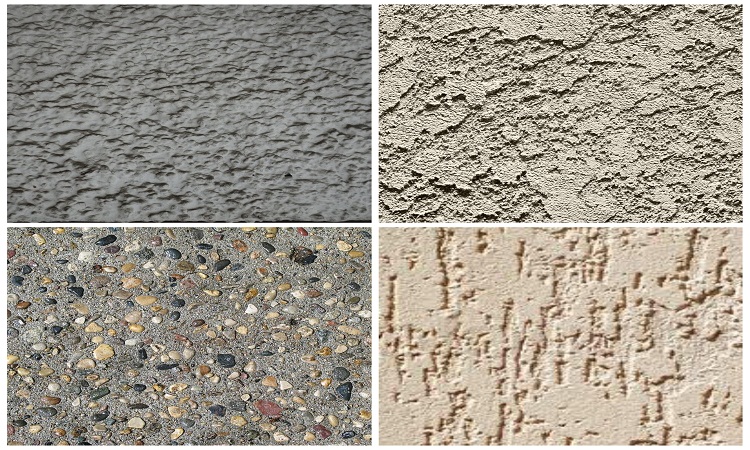Plastering is a process by which coarse or bristly surfaces of the walls and ceiling roofs are changed or rendered or turned to provide smoothness finish. At the beginning of plastering work, wet materials are spread over the brickwork, then suitable equipment is used to make the surface smooth level.
The objective of plastering is to obtain a smooth & hard surface that could be painted and provides nice aesthetic appearances.
Types of Plaster Finishes
After the application of plaster, finishing applied on the final coat of plaster following are some of the finishes given below.
- Smooth Coat Finish
- Rough Cast Finish
- Pebble-Dash Finish
- Textured Finish
- Depeter Finish
- Scrapped Finish
- Sand Faced Finish
Smooth Coat Finish
When a smooth finish is desired, the minimum amount of working should be applied to the wetted surface and a wooden float is to be used, rather than a steel trowel. Rendering shouldn’t be permitted to dry too quickly. When no neuron finish is desired, the mix should contain lime. The recommended proportions of cement, lime, and sand in the mortar vary from 1:1:6 for exposed surfaces to 1:2:9 for protected ones.

Rough Cast Finish
This finish is suitable for rural or coastal areas and for severe exposure conditions. This is a finish that is splashed onto the surface as a wet mix and left rough. The maximum size of sand, crushed stone or gravel varies from 12.5 mm to 6.3 mm.

Pebble-Dash Finish
This is the most durable of all finishes and is generally free from defects or deficiency. Pebble-dash finish gives a rough surface finish and is obtained by means of small pebbles or crushed stone, graded from 12.5 mm to 6.3 mm being dashed on to a fresh coat of mortar & then left exposed. The pebbles or crushed stones are sometimes lightly pressed or tapped into the mortar.
If the wall is exposed to severe weather conditions, cement and sand mix with an addition of a small quantity of lime is preferred. When this finish is to be applied on strong and dense backgrounds such as dense concrete blocks or structural concrete having a very smooth surface or uneven suction characteristics, a suction splatter-dash of rich mortar mix is applied and no subsequent smoothening is necessary.
Textured Finish
Textured finishes are now becoming very popular and maybe getting in a variety of ways in many different designs. Particular effects of textured finish can be getting by scraping the surface of the rendering with a straight edge hacksaw blade or/and with the edge of a steel trowel. The time to scrape must be chosen correctly. Some judgment is needed in this respect. Insufficient and excessive drying and hardening of the mortar surface have to be avoided. The period may vary from an hour to a day, depending on both the type of mix and climatic conditions.
Depeter Finish
This is just another form of a rough plaster finish. The rendering coat of 12 mm thick is prepared as in case of a pebble dash finish.
While this coat is wet, pieces of gravel are pressed with hands on the surface.

Scrapped Finish
The final coat of plaster 6 mm to 12 mm applied. Then it’s allowed to be stiffened for a few hours. The surface is scrapped in a pattern for a depth of 3 mm.
Steel straight edge old saw blades or such other tools may be used for scrap.
Sand Faced Finish
Sand faced finish is applied in two coats. The first coat is applied in 1:4 cement sand mortar thicknesses of 12 mm.
It is provided wish Zig-zing lines. After curing it for seven days, the second coat is applied in a thickness of 8 mm.
The mortar for the second coat is prepared from the cement sand mix ratio 1:1. The sand of uniform size is used. A sponge is used in the second coat of mortar when it is wet.
The surface of the final coat is finished by rubbing clean wand washed sand of uniform size by means of wooden float. This results in the surface having sand grains of uniform and equal density.

Special Material Used in Plastering for Finishing Coat
The following are the materials to be used for finishing the coat.
- Acoustic Plaster
- Asbestos Marble Plaster
- Barium Plaster
- Granite Silicone Plaster
- Plaster of Paris of Gypsum Plaster
- Keene’s Cement Plaster
Read More:-
Important Questions and Answers on Building Repairs Part-1
Different Types of Cracks in Concrete
What is Structural Appraisal? Principles and Guidelines for Structural Appraisal
What is Structural Audit? Methodology, Guideline, Related Issues, and Durability
The Structural Requirements of Reinforcing Steel
TMT Reinforcement Bars and In RCC Construction Basic Guideline
Building Damage Due to Natural Causes & Designing Procedure
Earthquake Resistant Design and Detailing of Structure
Principle and Practices Followed in the Design and Execution of Tall Buildings
Strengthening of Bridge Structures Using Carbon Fiber Reinforced Polymer (CFRP) System




